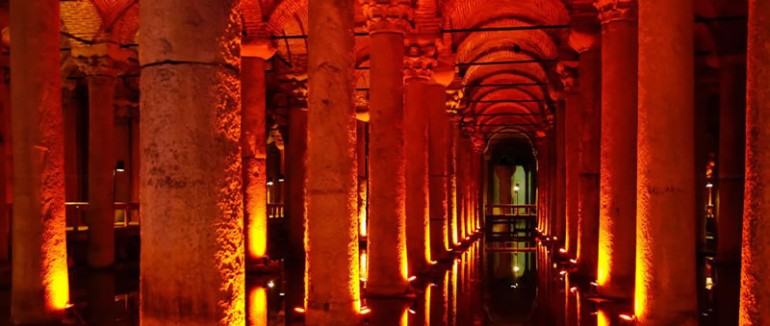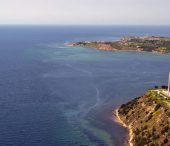The Basilica Cistern is located in close proximity to the Haghia Sophia, in Eminönü. The Basilica Cistern was built by the Roman Emperor Justinianus in 532 to fulfill the water demands of the city. It was named the Basilica Cistern as it was built under the Stoa Basilica.
The huge rectangular structure is 140 meters high and 70 meters wide. Visitors enter the cistern going down 52 steps made from stone. The cistern stands up with 336 columns, each nine meters high. The columns are 4.8 meters apart, aligned in 12 rows, each row containing 28 columns. Rising from the water on the ground, the cistern mesmerizes the visitor with its columns, resembling a forest.
The ceiling weight is held up with arches above the columns. Most of the columns are made from a single piece while some are made from two conjoined pieces, likely to have been gathered from older structures. The top part of the columns generally show different features. Ninety-eight of these are decorated with a Corinthian style while some resemble the Dor style. Some of the columns are built angled or grooved while most are made in cylinder shapes. Two of the columns in the northwest of the cistern have Medusa Heads, reflecting the state of sculpture art during the Roman Empire.
Built on a 9,800-m2 area, the cistern has the capacity to store about 100,000 tones of water.
The Basilica Cistern met the water needs of the people living around the area during the Byzantine Empire. After Istanbul was conquered in 1453, the water needs of the Topkapı Palace gardens were met from the cistern for a while. Preferring running water to still water, the Ottomans soon built water plantations to meet the water demand of the city.
Operating under the Istanbul Metropolitan Municipality Culture Inc. the museum, also hosts many international programs.
CONTACT
Address: Yerebatan Caddesi No: 13 Sultanahmet
VISITING HOURS
Opening Hours 09.00 – 17.30










